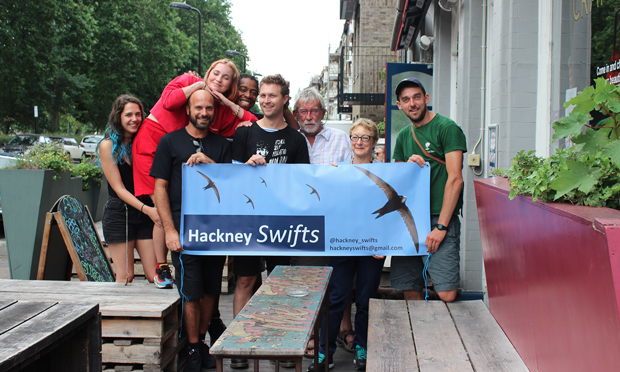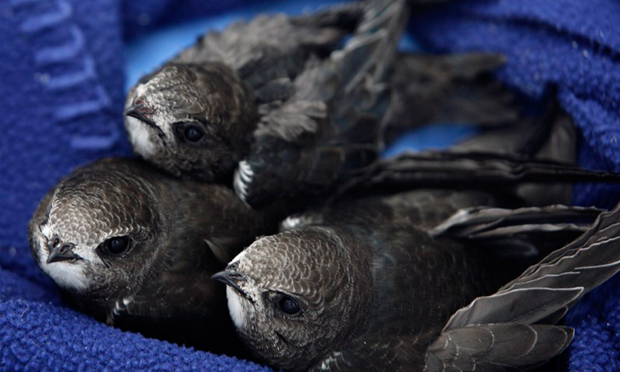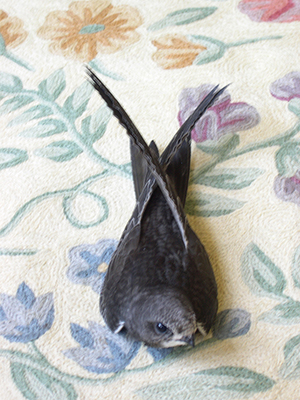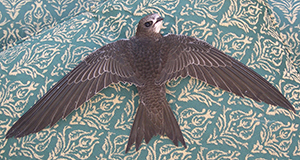Swift exit: is Hackney Council missing a big opportunity by exiling this most high-flying of birds?

Hamish Burnett (far-right) and supporters gathered outside e Star by Hackney Downs pub – which has swift boxes in situ. Photograph: Andrew Barnes
Last month, many hundreds of swifts will have made the 10,000 mile journey from sub-Saharan Africa (where they gorge on insects all winter following the path of the continents’ rainy seasons), across Spain and France, before setting up for the summer to breed in the UK and all across Europe. They arrived en masse in Hackney on May 5th.
And what better place than Hackney? After all, we have insects aplenty – indeed the British Pest Control Association study revealed that Hackney Council “dealt with more problems per head with cockroaches than any other authority in Britain last year.”
Actually, Hackney may well be more hostile to beleaguered birds than it lets on at street level. In the UK, swifts have declined by 42 per cent since 1990; a large part of this decline is thought to come from a lack of nesting sites.
Modern buildings are hermetically sealed by design against the smallest of insects, let alone swifts. Increased sprucing up of old Victorian properties in Hackney has further resulted in far fewer nesting sites under crooked tiles and sagging eavesboards.

Swifts, on a rare occasion when they are not flying high. Photograph, and those below: Deborah Lauterpacht
With this in mind, I and other swift fans in Hackney have kicked off a campaign to preserve swifts and find out how many of the borough’s new developments have included swift boxes – housing tailored for swifts.
We have so far been frustrated by the answers, or lack thereof. Two Freedom of Information requests to Hackney Council have yielded no information on the provision of swift boxes on new developments. We are not aware of any that have been installed without our input (Pembury Circus and Kingsland Basin are a few of the places where we have helped to get them included in designs).

So many new high rise developments in Hackney are 100 per cent suitable for swift nest boxes, ticking all the boxes of five metres high, north facing and close to existing swift colonies.
I recently observed a party of swifts prospecting for entrance holes on the brick facade of the new flats on Dalston Lane. Denied entry, of course.
This building could have easily included a set of internal swift boxes providing scintillating evening flying displays for residents. Why weren’t they insisted on as a condition of planning by Hackney Council?
We understand councils have a complex and demanding job, and so we have offered them our assistance in identifying where to install boxes. In the meantime, volunteers diligently comment on council planning applications.
Swifts are an incredible creature to share your home with. A relative of hummingbirds, they fly at jedi speed through the urban roofscape, clocking speeds of up to 70mph in their evening displays. For many they encapsulate the spirit of summer with their joyous evening flights and shrill passionate calls (the soundtrack to many a period romance, such as Atonement).
Swifts pair for life and are loyal to the same nesting site. They hoover up mosquitoes and other flying insects and are highly valued in Italy and Spain for their bug removal services.
Once a nest site is lost swifts may stun and kill themselves trying to re-enter. Such a drama unfolded locally when a landlord blocked access to a nest site and refused to remove the offending scaffold board. The proactive tenant of the property contacted us, and we were able to persuade the landlord to remove the board after pointing out that this was illegal.

To provide a future for swifts in the borough, Hackney Swifts have set up nest boxes in St John at Hackney, installed a swift call player in existing boxes in St Peter de Beauvoir and most recently installed five boxes and a call player at The Star by Hackney Downs pub. We are monitoring these sites and are hopeful swifts will take up residence.
Everyone who delights in the wonderful swift is extremely grateful to the maverick band of pub landlords, church wardens and local residents who are supporting our life enhancing swifts. Until Hackney Council asks developers to do their bit too, this is all that protects them from non-stop decline in Hackney.
Here’s what to do if you want to keep swifts in Hackney.
1) Notice and enjoy them, chat to your friends about them, look out for low level screaming parties which means they’re nesting nearby.
2) Contact your local councillor to insist Hackney Council makes provision of swift nest boxes a condition of planning on all suitable new builds and renovations.
3) If you notice scaffolding up and suspect swifts are nesting, inform the home owner or landlord, we can advise on how to keep the nesting sites whilst work continues: email hackneyswifts@gmail.com
4) Put up a swift box with a call player, the calls will attract swifts and you can foster a new colony. Search ‘action for swifts’ and ‘swift conservation’ for plenty of advice.
